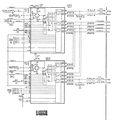M377: Difference between revisions
| Line 117: | Line 117: | ||
| bgcolor="LightBlue" | analog control signals | | bgcolor="LightBlue" | analog control signals | ||
|} | |} | ||
<gallery> | <gallery> | ||
M377 as u310 and u410 in 11a52.jpg|M377 in an [[11A52]], as U310 and U410. Each M377 chip has a differential output impedance of 200 Ω. The two chips' outputs are in parallel, driving the output pins of the plug-in with a differential impedance of 100 Ω, or 50 Ω per side. | M377 as u310 and u410 in 11a52.jpg|M377 in an [[11A52]], as U310 and U410. Each M377 chip has a differential output impedance of 200 Ω. The two chips' outputs are in parallel, driving the output pins of the plug-in with a differential impedance of 100 Ω, or 50 Ω per side. | ||
Revision as of 08:40, 2 November 2018
The M377 is a Tek-made amplifier integrated circuit designed by John Addis. It is used in the 11A16, 11A32, 11A33, 11A34, and 11A52.
About the M377, John Addis says:
The M377 was a single channel plugin on a chip with 0 V common mode input and output voltages, excellent variable gain control, two four pole bandwidth limits, three outputs which could be separately inverted and turned on or off.
It was the first wideband analog IC with level shift on chip (allowing 0 V common mode input and output and without PNP transistors), first wideband amplifier with any on-chip bandwidth limit selection, first to have more than two fixed gain settings (it has six), and first to require only one transient response adjustment (no thermals), and the first to have a highly linear relationship between a control voltage and gain. It also had excellent overdrive recovery.
The packaged M377 die has the following Tek part numbers:
- 165-2129-03
- 165-2089-06
- 155-2089-05 (11A33)
165-2089-xx Pinout
Pin function legend
Links |



